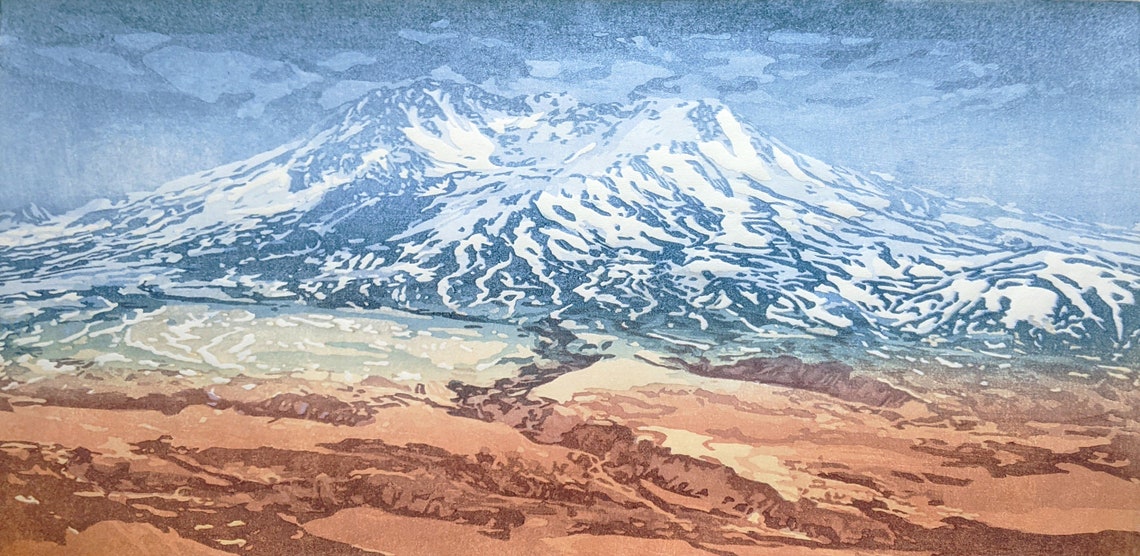

He focuses on the effect of his work and not only the printing itself. "I am trying to make woodblock prints that don't look like woodblock prints - the wood and the knife invisible, the colors and edges as soft and resonant as a watercolor." "I work in the traditional Japanese moku-hanga woodblock technique for many reasons. it is simple, in the way that making a pot is simple: wood and paper, water and pigment, hand and tool. Yet the process is simultaneously complex, challenging my craftsmanship at every turn.

"Multiple-block printmaking is not spontaneous. Most of the work for every print is in the days and weeks of preplaning and the months of endless color-testing, remixing, recarving, washing all the blocks and brushes, and beginning again.

Even when a satisfactory test proof is achieved, the printing of the final edition is unpredictable. I have been practicing moku-hanga for almost 30 years now, yetI feel I am just beginning to expolre the potential of this medium." -Michah Schwaberow "Watercolor printed from carved wooden blocks is unlike any other color I know. Illustration: Permission Solo, Micah Schwaberow Ticket Informationįree after museum admission.
#Moku hanga blocks full#
Seating is first come, first served and available on a drop-in basis, although we do recommend attending for the full hour-long talk.Neil Malone, Passing through 1-2, 2020, water-based mokuhanga, sumi stencil and wood engraving, 64 x 48.5 cm, unique state. Susan Rushforth, Passing Clouds VII, 2021, woodblock print using water-based pigments on handmade Japanese Kozo paper, 35 x 70 cm, unique state. Reproduced with permission of the artist.ĭeborah Metz, Sea Sponge Shapes with Eroded Rock Face Pattern, 2021, four-block mokuhanga, 40 x 57 cm, edition varied.

Roslyn Kean, Winter Courtyard Shadows, 2021, multi-block mokuhanga with gold leaf, 76 x 56 cm, U/S. Reproduced with permission of the artist. Trish Yates, Forest Glow, 2021, woodblock, wax, sumi ink, double backed accordion style artist’s book, 11 x 15 x 26 cm, unique state. To print, the artist uses a baren, a flat, hand-held disk that is wrapped in a bamboo sheeth, to press the pigment into the paper.Reproduced with permission of the artist.Įma Shin, Origin #7, 2005, water-based woodblock print with sumi, nishinouchi washi, 55 x 40 cm, edition of 15.
#Moku hanga blocks registration#
A sheet of sized and dampened paper is then placed on the block proper alignment is insured by two registration marks that are carved into each block at the same place. Pigment dispersed in a water and rice paste are placed on the block and smoothed across the surface with a brush that looks similar to a shoe brush. Areas that are not to be printed are cut away, leaving a raised surface, as in the principle of a stamp. Initially, the artist carves a block of wood for each color to be printed. To move from the inspiration of the sketch to the mechanics of the print requires thoughtful organization of color and space. The process, however, is labor intensive for the artist, who must undertake the roles of designer, carver, and printer. Wood, water, paper, pigment, paste, and simple carving and rubbing implements are all that is needed to make a print. Japanese woodblock printmaking, moku (wood) hanga (print), is distinguished from other printmaking techniques by the simplicity of material involved in its creation.


 0 kommentar(er)
0 kommentar(er)
